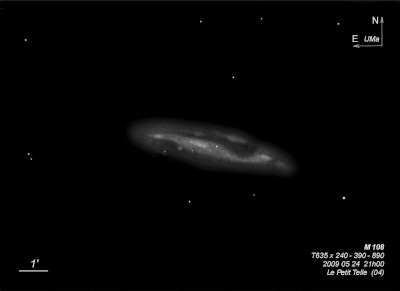
Pierre Méchain discovered M108 = NGC 3556 = V-46 = h831 on 16 Feb 1781 with a 3-inch refractor. Messier measured an accurate position and added it by hand to his personal copy of the catalogue, but a later edition was never published.
William Herschel independently discovered the galaxy on 17 Apr 1789 (sweep 922) and recorded H. V-46 as "vB, 10' long and 2' br, resolvable. An unconnected pB star in the middle." Herschel was credited with the discovery in the NGC. John Herschel made a single observation on 10 Feb 1831 (sweep 324) and wrote, "B; vL; p b r; vmE; pos 79°. Has a distinct star in centre and 1 or 2 vS stars elsewhere." At Birr Castle, M108 was observed 7 times, first on 13 Apr 1850. It was described in various observations as "twisted", "mottled", "patched and irregular", "knots".
300/350mm - 13.1" (2/25/84): fairly bright, very elongated, stellar nucleus.
400/500mm - 17.5" (2/25/84): very bright, very large, edge-on 4:1 WSW-ENE, 8.0'x2.0'. A mag 12 star is superimposed just west of center (V = 12.5) appearing similar to a bright stellar nucleus. Two fainter stars are also superimposed east of the core. A bright knot is visible west of the core (1.3' W of the star) and the region near the core appears dusty. A mag 12 star is just south of the west end, 4.9' from the center.
17.5" (3/12/88): very bright, very large, a bright star is superimposed near the center, knot visible west of the core.
900/1200mm - 48" (5/12/12): extremely bright and large, very elongated at least 4:1 WSW-ESE, ~8'x2'. M109 displayed a unique tortured appearance and was riddled with irregular dust lanes and patches. A very irregular dust lane courses through the galaxy along the major axis, but north of the core. A bright mag 12.5 Milky Way star is superimposed just west of center and east of this star is a bright, large elongated knot [HK83] 87. Very close west of the star is a small, faint knot [HK83] 108 and a large dust patch is just west of this knot. On the west edge of the dust patch (1.2' W of the star) is another bright, elongated knot with multiple HII designations including [HK83] 146.
Notes by Steve Gottlieb